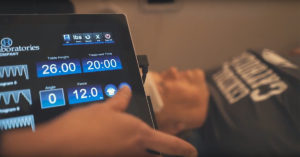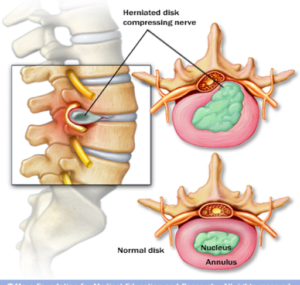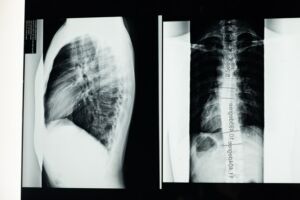Back injuries can be life-changing even when they heal within a few months. Back pain that recurs frequently or becomes chronic may disrupt your work, family, and social life for years. Finding effective treatments for stubborn back pain can be challenging. Some causes are easy to identify, while others are more elusive, even with detailed imaging. Back surgery carries many risks and fails nearly half of patients.
Spinal decompression therapy is a safe, FDA-cleared treatment that’s proven to improve symptoms in over eighty percent of patients. Decompression therapy addresses the root causes of back pain and helps the body heal. This leads to long-term pain relief.
Here are five things you should know about this innovative treatment:

1. How Does Spinal Decompression Therapy Work?
Spinal decompression therapy is a type of motorized traction. It gently stretches the spine, creating negative pressures between vertebrae. It’s the only type of traction proven to achieve this. Negative pressures relieve pinched nerves and draw nutrients, oxygen, and blood flow to the space around the disc and to the facet joints. These areas often struggle to heal due to a lack of blood flow. Spinal decompression also moves bulging discs back into place. The net result of these actions is a physiological change in the spine that reduces inflammation, realigns discs and vertebrae, and encourages healing.
Spinal decompression therapy even rehydrates degenerating discs. Though it can’t return them to their original state, it helps the disc create more space between vertebrae, taking pressure off nerves.
No other treatment can affect all these changes to so many spinal structures.
The process of decompression therapy is comfortable and relatively short. You’ll be comfortably secured to a computer operated table. After your provider programs a personalized treatment plan, the table will move, gently stretching your spine. Each treatment lasts thirty to forty minutes on average.

2. What Conditions Does it Treat?
The spine is a complex structure made up of many pieces that can cause pain. Facet joints, discs, nerve roots, and surrounding musculature are all subject to injury and disease. Pinpointing the cause of a patient’s pain can, therefore, be challenging. Inflammation and irritated nerve roots are difficult to spot on imaging and impossible to treat with surgery or medication. Facet syndrome and degenerated discs may show on imaging but are likewise difficult or impossible to treat with invasive procedures.
Spinal decompression therapy treats the whole spine and can even treat problems the provider can’t see. Some of the most common diagnoses treated with spinal decompression include herniated and bulging discs, facet syndrome, degenerative disc disease, and idiopathic back pain (meaning that the cause is unknown.)
Patients with new injuries and those with long-term back pain can benefit from decompression therapy. When used to treat a recent injury, it improves healing outcomes and reduces the risk of chronic pain. Patients with disc injuries are excellent candidates for decompression therapy. Discs lack blood flow and are often slow to heal. Decompression therapy speeds healing and desensitises nerves. It’s common for chronic pain patients who’ve tried “everything” to finally find relief after spinal decompression. Many of these patients are suffering from undiagnosed low level inflammation, a stalled healing process, or nerve irritation. Spinal decompression therapy reduces their dependence on pain medications and, in some cases, prevents surgery.

3. Does It Take a Long Time to Work
Like many treatments, spinal decompression therapy requires more than one session. Your provider will determine your treatment plan based on your injury and response to treatment. Most patients treating stubborn back pain receive anywhere from twelve to thirty sessions over four to six weeks. To begin, your treatments will be spaced close together, possibly a few per week, then become less frequent. It’s important to finish your treatment plan. Patients who quit early have a much higher risk of recurring pain.
Compared to surgery, which typically requires a six-month healing period, spinal decompression therapy works quickly. It’s important to remember that the therapy is helping your body heal, and that process takes time. Most patients experience some relief after the first week of treatment and continue to improve after that. The payoff to finishing your treatment plan is long-term relief.

4. Are There Any Risks?
When performed by a trained professional, spinal decompression therapy is among the safest treatments available. The most common side effect is temporary muscle soreness. Some patients experience this because their muscles have been working in a way they aren’t used to, similar to when you try a new workout routine. People with a severely painful disc injury may feel discomfort during or right after treatment, but it won’t be worse than the pain you are treating. Most patients find their pain decreases during therapy as pressure is taken off nerves.
Though safe for most people, there are some contraindications. People with tumors near their spine, spinal cord trauma, a history of an abdominal aneurysm, and pregnant women should not be decompressed.

5. Can it Treat Failed Back Surgery?
Yes! Many patients have found relief from post-surgical back pain with spinal decompression therapy. If your back surgery was at least six months ago and you didn’t have any fusions or metal implants, you may be a candidate for decompression.
Many back surgeries fail due to surgeon error or misdiagnosis. As we discussed earlier, it’s challenging to pinpoint the exact cause and location of a patient’s pain. Surgeons can only treat damage they can see. Since spinal decompression treats a more extensive section of the spine, it can address problems doctors missed.
Spinal Decompression Therapy in Tennessee
At Stanlick Chiropractic, we offer spinal decompression to patients suffering from disc injuries, arthritis, and other painful conditions. We’ve seen the difference this treatment has made in our patients’ lives. Schedule a consultation today to find out if spinal decompression therapy is right for you.

